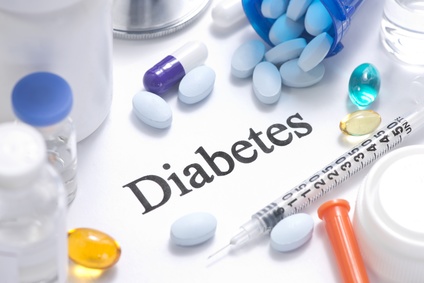Diet-controlled patients.
In patients with type 2 diabetes who are well controlled with diet alone, the risk associated with fasting is quite low. Distributing calories over two to three smaller meals during the non-fasting interval may help prevent excessive postprandial hyperglycemia. Patients controlled with diet alone usually combine this with a regular daily exercise program.
The exercise program should be modified in its intensity and timing to avoid hypoglycemic episodes; the timing of the exercise could be changed to ∼2 hours after the sunset meal. Finally, in this usually older age-group, often with hypertension and dyslipidemia, fluid restriction and dehydration may increase the risk of thrombotic events.
Patients treated with oral agents.
The choice of oral agents should be individualized. In general, agents that act by increasing insulin sensitivity are associated with a significantly lower risk of hypoglycemia than compounds that act by increasing insulin secretion.
- Metformin. Patients treated with metformin alone may safely fast because the possibility of hypoglycemia is minimal. However, it is suggested that the timing of the doses be modified.
Two-thirds of the total daily dose be administered in iftar, while the other third be given in sehri.
- Glitazones. Patients on insulin sensitizers (pioglitazone) have a low risk of hypoglycemia. Usually, no change in dose is required. Taken at night or iftar.
- Sulfonylureas. Newer members of the sulfonylurea family (gliclazide MR or glimepiride) have been shown to be effective, resulting in a lower risk of hypoglycemia. If taken once daily before Ramadan then should be taken full dose in iftar. If taken twice a day then full morning dose in iftar and half of the night dose in sehri.
- Short-acting insulin secretagogues. Members of this group (repaglinide and nateglinide) are useful because of their short duration of action. They could be taken twice daily in iftar and in sehri.
- Incretin-based therapy. Glucagon-like peptide-1 receptor agonists (GLP-1ras) exenatide and liraglutide and dipeptidylpeptidase-4 inhibitors (DPP-4is) alogliptin, saxagliptin, sitagliptin, and vildagliptin. These classes of agents are not independently associated with hypoglycemia, though they can increase the hypoglycemic effects of sulfonylureas, glinides, and insulin. During Ramadan, these drugs do not require dose titration. Can be taken at night or in iftar
- α-Glucosidase inhibitors. Acarbose, miglitol, and voglibose slow the absorption of carbohydrates when taken with the first bite of a meal. Because they are not associated with an independent risk of hypoglycemia, particularly in the fasting state, they may be particularly useful during Ramadan. α-Glucosidase inhibitors are associated with frequent mild to moderate gastrointestinal effects, particularly flatulence. Using modest doses and slowly initiating therapy are reported to minimize the frequency of these adverse effects
Patients treated with insulin.
Problems facing patients with type 2 diabetes who administer insulin are similar to those with type 1 diabetes, except that the incidence of hypoglycemia is less. A major objective is to suppress hepatic glucose output to near-physiologic levels during the fasting period. Judicious use of intermediate- or long-acting insulin preparations plus a short-acting insulin administered before meals would be an effective strategy.
There is some evidence suggesting that the use of insulin lispro instead of regular insulin before meals in patients with type 2 diabetes who fast during Ramadan is associated with less hypoglycemia and smaller postprandial glucose excursions.
- Short/Rapid-acting insulin, take the usual dose in iftar and 25-50% reduced dose in sehri.
Using one injection of a long-acting insulin analog, such as insulin glargine, or two injections of NPH, lente, or detemir insulin before the sunset and predawn meals may provide adequate coverage as long as the dosage of each injection is appropriately individualized.
- Basal analogues (intermediate/long-acting) once daily, same time at night or in iftar by 20-30% dose reduction.
- Intermediate-acting insulin twice daily, full morning dose in iftar and half of the night dose in sehri.
A single injection of intermediate-acting insulin administered before the sunset meal may be sufficient to provide acceptable glycemic control in patients with reasonable basal insulin secretion. However, most patients will still require short-acting insulin administered in combination with the intermediate- or long-acting insulin at the sunset meal to cover the large caloric load of iftar. Moreover, many will need an additional dose of short-acting insulin at predawn.
- Premixed insulin or split mixed insulin dose during Ramadan should be in iftar full pre-Ramadan morning dose and in sehri half of the night dose.
Pregnancy and fasting during Ramadan
Pregnancy is a state of increased insulin resistance and insulin secretion and of reduced hepatic insulin extraction. Fasting glucose concentrations are lower but postprandial glucose and insulin levels are substantially higher in healthy pregnant women than those who are not pregnant. Elevated blood glucose and A1C levels in pregnancy are associated with increased risk for major congenital malformations.
Fasting during pregnancy would be expected to carry a high risk of morbidity and mortality to the fetus and mother, although controversy exists. While pregnant Muslim women are exempt from fasting during Ramadan, some with known diabetes (type 1, type 2, or gestational) insist on fasting during Ramadan. These women constitute a high-risk group, and their management requires intensive care.
In general, women with pre-gestational or gestational diabetes should be strongly advised to not fast during Ramadan. However, if they insist on fasting, then special attention should be given to their care. The management of pregnant patients during Ramadan is based on an appropriate diet and intensive insulin therapy. The issues discussed above concerning the management of type 1 and type 2 diabetes also apply to this group, with the exception that more frequent monitoring and insulin dose adjustment is necessary

